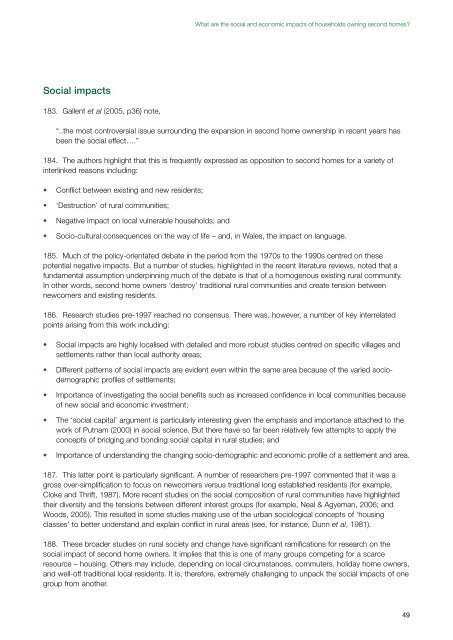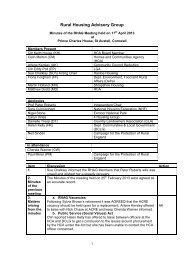Rapid Evidence Assessment of the Research ... - Rural Housing
Rapid Evidence Assessment of the Research ... - Rural Housing
Rapid Evidence Assessment of the Research ... - Rural Housing
Create successful ePaper yourself
Turn your PDF publications into a flip-book with our unique Google optimized e-Paper software.
Social impacts<br />
183. Gallent et al (2005, p36) note,<br />
What are <strong>the</strong> social and economic impacts <strong>of</strong> households owning second homes?<br />
“..<strong>the</strong> most controversial issue surrounding <strong>the</strong> expansion in second home ownership in recent years has<br />
been <strong>the</strong> social effect….”<br />
184. The authors highlight that this is frequently expressed as opposition to second homes for a variety <strong>of</strong><br />
interlinked reasons including:<br />
• Conflict between existing and new residents;<br />
• ‘Destruction’ <strong>of</strong> rural communities;<br />
• Negative impact on local vulnerable households; and<br />
• Socio-cultural consequences on <strong>the</strong> way <strong>of</strong> life – and, in Wales, <strong>the</strong> impact on language.<br />
185. Much <strong>of</strong> <strong>the</strong> policy-orientated debate in <strong>the</strong> period from <strong>the</strong> 1970s to <strong>the</strong> 1990s centred on <strong>the</strong>se<br />
potential negative impacts. But a number <strong>of</strong> studies, highlighted in <strong>the</strong> recent literature reviews, noted that a<br />
fundamental assumption underpinning much <strong>of</strong> <strong>the</strong> debate is that <strong>of</strong> a homogenous existing rural community.<br />
In o<strong>the</strong>r words, second home owners ‘destroy’ traditional rural communities and create tension between<br />
newcomers and existing residents.<br />
186. <strong>Research</strong> studies pre-1997 reached no consensus. There was, however, a number <strong>of</strong> key interrelated<br />
points arising from this work including:<br />
• Social impacts are highly localised with detailed and more robust studies centred on specific villages and<br />
settlements ra<strong>the</strong>r than local authority areas;<br />
• Different patterns <strong>of</strong> social impacts are evident even within <strong>the</strong> same area because <strong>of</strong> <strong>the</strong> varied sociodemographic<br />
pr<strong>of</strong>iles <strong>of</strong> settlements;<br />
• Importance <strong>of</strong> investigating <strong>the</strong> social benefits such as increased confidence in local communities because<br />
<strong>of</strong> new social and economic investment;<br />
• The ‘social capital’ argument is particularly interesting given <strong>the</strong> emphasis and importance attached to <strong>the</strong><br />
work <strong>of</strong> Putnam (2000) in social science. But <strong>the</strong>re have so far been relatively few attempts to apply <strong>the</strong><br />
concepts <strong>of</strong> bridging and bonding social capital in rural studies; and<br />
• Importance <strong>of</strong> understanding <strong>the</strong> changing socio-demographic and economic pr<strong>of</strong>ile <strong>of</strong> a settlement and area.<br />
187. This latter point is particularly significant. A number <strong>of</strong> researchers pre-1997 commented that it was a<br />
gross over-simplification to focus on newcomers versus traditional long established residents (for example,<br />
Cloke and Thrift, 1987). More recent studies on <strong>the</strong> social composition <strong>of</strong> rural communities have highlighted<br />
<strong>the</strong>ir diversity and <strong>the</strong> tensions between different interest groups (for example, Neal & Agyeman, 2006; and<br />
Woods, 2005). This resulted in some studies making use <strong>of</strong> <strong>the</strong> urban sociological concepts <strong>of</strong> ‘housing<br />
classes’ to better understand and explain conflict in rural areas (see, for instance, Dunn et al, 1981).<br />
188. These broader studies on rural society and change have significant ramifications for research on <strong>the</strong><br />
social impact <strong>of</strong> second home owners. It implies that this is one <strong>of</strong> many groups competing for a scarce<br />
resource – housing. O<strong>the</strong>rs may include, depending on local circumstances, commuters, holiday home owners,<br />
and well-<strong>of</strong>f traditional local residents. It is, <strong>the</strong>refore, extremely challenging to unpack <strong>the</strong> social impacts <strong>of</strong> one<br />
group from ano<strong>the</strong>r.<br />
49






